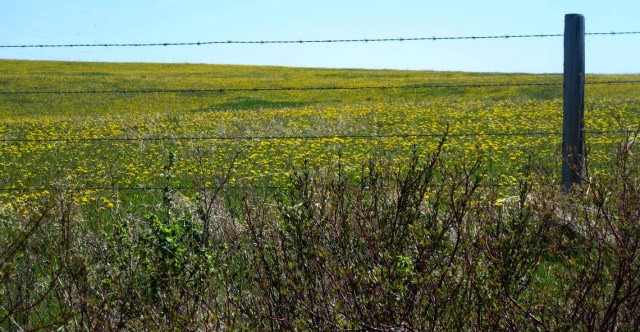
If you travel metro in London (and many other cities) you might hear a polite admonition from the public address system, “Mind the gap!” It’s advising you not to get your footwear stuck between the train and platform while boarding. Beekeepers have their own gap to mind and it’s here now.
The June Gap is pretty common across the northern hemisphere. (Perhaps there’s a December Gap down in Chile.) The gap is so renowned among beekeepers that someone built a wikipage called “June Gap”. It relates mostly to the UK, but we also gap here, in western Canada, too. This is what the wiki says:
The June Gap refers to a phenomenon in which a shortage of forage available for bees occurs (typically in June) and has been observed in the United Kingdom and Ireland.
Subsequent to the massive volume of pollen and nectar produced by trees and hedges in the spring, there is a reduction in the amount of nectar available to the bees due to long grasses and dandelions suppressing many wildflowers.[1] Before the herbaceous “summer rush” of July-through-September which reinstates the high level of nectar, the high hive populations brought around by trees in the spring struggle to produce honey and may lay fewer eggs. Beekeepers need to pay special attention to the levels of honey in the hive as well as the level of water the bees use during this gap. Annual weather patterns can cause this event to occur later or earlier.
Some plants which can help provide nectar in this gap are Cotoneaster, the closely related Pyracantha, common garden [herbs], and perennial garden plants.
That’s all the Wikipedia entry says, then a few references are cited. The June Gap isn’t limited to England and Ireland. We also gapped in western Pennsylvania, where I learned to keep bees. We saw a nice early flow from of willow, dandelion, and fruit blossom. Most years, black locust (Robinia pseudoacacia) straddled late May and early June followed by tulip poplar (Liriodendron tulipifera) and basswood (linden, or Tilia americana). Then there was a (summer) gap until the autumn goldenrod and aster. Farther north and west, most beekeepers on the American plains and Canadian prairies also suffer a real June Gap, a dearth between spring flows and our main summer honey flow.

A great pasture for bees: dandelions, before the gap
What happens during the gap? There is often a little pollen coming in, but rarely is there much nectar. For those of us lucky enough to live in Alberta, Canada, we may have a good flow from dandelion (this year it peaked on May 25th, which is normal) but the drop after that major source is precipitous. We have sparse flowers (goat’s beard, buffaloberry, Siberian olive, caragana) which tease the bees a bit, but we can see hives lose weight, even on sunny mild June days. Most years, we have gaps (of varying significance) from about June 5th to June 25th. During those three weeks, queens curtail egg laying. Crucial workers that will help make the late July and August part of the honey crop might not materialize in the numbers you need.
Beekeepers have taken to feeding their bees up to a few days before honey supers go on. If the dearth is severe and hives have built up strongly on the early season flows, the gap will result in less brood rearing. But the gap can be so serious that bees destroy their developing brood and then, as it continues, they may starve. It’s possible to lose hives from starvation days before the main flow starts. Leaving plenty of reserve honey in the hive will, of course, prevent such a fate. But even a well-provisioned colony usually stops egg laying when the nectar shuts off and pollen becomes scarce.
The solution? Mind the gap. Keep a couple of eyes on your hives at this time of the year. The crop (for most of us) will start flowing in less than a month. This is not the month to ignore your bees.

Pingback: Mind the Gap! | How To Raise Bees
good to know, thank you 🙂
LikeLiked by 1 person
Hi, Ron—I was acutely aware when first becoming a beekeeper in Southern Calif that the massive flows of the temperate climates did not happen here at all similarly. Sourwood, maples, pussywillows, etc, (the plants mentioned in many typical books) are not attuned by the harsh seasonal shifts of temperature, so I had to make other observations. Since much of the semi-desert of Southern Calif has been planted with things from the southern latitudes —So Africa, New Zealand, Australia—we have things blooming in Winter and pretty much all year. Drought has, till just this past winter, made the forage poor and many hives in the surrounding foothills, dependent on native shrubs and perennials, did suffer for the last 6 or 7 years. With over 18 inches of rain since October, the trees, shrubs, and weeds have been very abundant. So, anyone reading and living in a similar Mediterranean climate has to think differently from what you describe!
LikeLiked by 1 person
Absolutely right! You’ve heard them say, “All beekeeping is local.” That’s why I mentioned ‘the north’ in my piece, but even that is a generalization.
Glad to hear that your drought seems to have ended (for now!) and bees are locally flourishing!
LikeLike
Yeah—but almost ALL the books are from temperate climes, so newbees starting up here get corn-fused by the “flows” discussions! And I don’t know how many newbees are on your site, so I carefully composed that remark to grab them. We do have one self-published book, by Jeremy Rose, “Beekeeping in Coastal California” which must be ordered from him directly. He’s listed on-line. It is a valuable resource for the month by month tutorials on management (he is definitely anti-feral, anti-AHB, and pro-treatments, but that’s OK) and the picture gallery of forage plants. There is NOTHING else like it for us MedClime beeks.
LikeLiked by 1 person
Thanks again, Susan. Westcoast beekeepers can buy a copy of Jeremy’s book through his website, at this link.
LikeLike
Pingback: Mind the Gap! | Raising Honey Bees
In Tasmania, Australia it is the November gap.
LikeLike
A November gap! Here in Canada, in addition to our early summer June Gap, we also have a November gap. It continues through December, January, February, and March! (It’s our winter gap, of course.)
Is it mild enough for you to have some winter blossom? Is your November gap related to rainfalls and droughts? Our June gap is simply due to the wrap up of our spring flows and a few weeks break until the commercial (alfalfa, canola) crops kick in.
LikeLike
Virginia in the U.S. tends to have a July-August gap. Our June typically has nectar available from late spring / early summer trees. Depending on our rains, the fall flow is a bit hit-or-miss as well, so many beekeepers feed in July/August to get their hives up to winter weight by September.
I like the analogy to the London subway.
LikeLike
I’m in Alabama and we get it too. Our spring flow is winding down now and there won’t be much in the way of nectar until Goldenrod starts in August. Last year, we had a serious drought starting about the same time as the usual dearth, so the typical late-summer/fall plants were a complete failure and there was lots of emergency feeding going on.
LikeLiked by 1 person
When I was a Pennsylvania beekeeper, we had a similar drought in year which had a bright sunny spring that brought lots of honey. My father said, “Leave the honey on the hives. That might be all they get until next year.” I didn’t believe him, of course. But he was right.
By the way, You have a nice blog over there at “Seven Stings”!
LikeLike
Last year there weren’t many signs that there was going to be trouble until after the spring honey had already been harvested and extracted. It just…quit raining. 60+ straight days with no measurable rain. I’m not seeing a bounceback spring, but then again I’ve had to concentrate on producing bees rather than honey this year so I wasn’t really expecting much of a honey crop.
Thanks for checking out my blog. It kind of started out as a bunch of Google calendar entries that I was using to keep track of what I was doing. But I’ve found that I really like sharing what’s going on in the beeyard.
LikeLike
I am not a Bee Keeper but have noticed honey bees feeding on fallen pears in my yard which peaked my curiosity and in my research discovered it could be that there is a nectar dearth. I know most of my flowers are finished for the year so because of this occurrence I have raked what’s left of my fallen pears under a tree for the bees.
LikeLiked by 1 person
What a great idea!
LikeLike